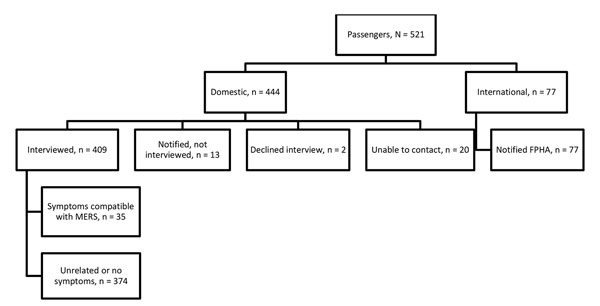Volume 23, Number 9—September 2017
Dispatch
Conveyance Contact Investigation for Imported Middle East Respiratory Syndrome Cases, United States, May 2014
Figure 2

Figure 2. Flowchart of aircraft passengers exposed to index case-patient 2 in investigation of 2 imported US cases of Middle East respiratory syndrome, by location at time of notification, May 2014. Of all passengers 188 (36%) were on the London–Boston flight, 158 (30%) on the Boston–Atlanta flight, and 175 (34%) on the Atlanta–Orlando flight. Domestic passengers were assigned to state health departments for follow-up if contact information indicated they lived in that state. CDC assumed responsibility for interviewing passengers if they lacked contact information that would enable state health department assignment. A total of 337 contacts were interviewed late in the incubation period (days 11–14 after exposure) and were not contacted for a follow-up interview after the incubation period; remaining contacts were interviewed after the incubation period. FPHA were notified for foreign passport holders and US citizens living or traveling abroad. The incubation period for MERS is 2–14 days after exposure. Symptoms compatible with MERS were fever (>38°C [100.4°F]), feverishness, symptoms of acute respiratory illness (i.e., cough, shortness of breath, rhinorrhea, sore throat), myalgia, malaise, or gastrointestinal symptoms in persons who traveled on the same conveyance as the index case-patient. CDC, Centers for Disease Control and Prevention; FPHA, foreign public health authority; MERS, Middle East respiratory syndrome.